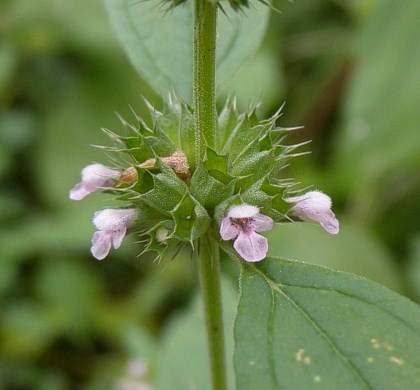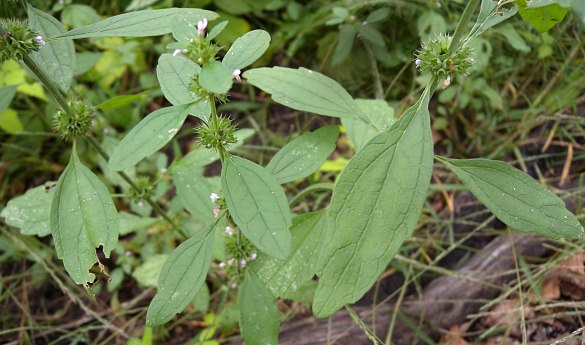
The flowers occur in dense axillary clusters along the upper half of each stem; these floral clusters are whorled and sessile. Individual flowers are about ¼" (6 mm.) long and 1/8" (3 mm.) across, consisting of a 2-lipped tubular corolla with 4 lobes, a calyx with 5 teeth that have spine-like tips, 4 stamens, and a pistil with an ovary that is divided into 4 parts. The corolla is white to pink and softly short-hairy along the exterior of the upper lobe, which functions as a protective hood. There is also a rounded lower lobe and two smaller lateral lobes. A patch of red occurs within the throat of the corolla. The calyx is light green, sparsely canescent along its exterior, and 5-veined. The corolla of the flower is about the same length as the calyx (including the tips of its teeth) or a little longer. The blooming period occurs from
Cultivation: The preference is full sun to light shade, moist to dry-mesic conditions, and loamy, rocky, or sandy soil that is calcareous. Depending on fertility of the soil, moisture levels, and time of year, individual plants can vary considerably in their height.
Range & Habitat: False Motherwort is uncommon to occasional in both central and NE Illinois, while in the rest of the state it is rare or absent. This plant is not native to Illinois; it was accidentally introduced into North America from Eurasia. Habitats include dolomite prairies, sandy savannas near Lake Michigan, riverbanks, roadsides, and pastures. This plant is usually found in disturbed areas, although it sometimes occurs in higher quality habitats.
Faunal Associations: Very little is known about floral-faunal relationships for this plant in North America, although they are probably similar to those for Motherwort (Leonurus cardiaca), which is closely related to False Motherwort and more common. The flowers are likely pollinated by various bees, including bumblebees, little carpenter bees (Ceratina spp.), and Halictid bees (Halictus spp., Lasioglossum spp.), which seek nectar or collect pollen from the flowers. Syrphid flies may also visit the flowers to feed on pollen, but they are less effective at cross-pollination. The Currant Aphid (Cryptomyzus ribis) uses Leonurus spp. (Motherworts) as summer hosts. Because of the bitter foliage, it is unlikely that mammalian herbivores browse on False Motherwort to any significant extent.
Photographic Location: A sandy oak savanna near Lake Michigan at the Indiana Dunes State Park in NW Indiana.

Comments: Across different populations, the leaf blades of False Motherwort can vary significantly in their width and in the abundance or size of the teeth along their margins. This plant is sometimes referred to as Leonurus marrubiastrum, but it differs from Leonurus spp. (Motherworts) by the lack of cleft lobes on its leaves. Like Motherwort (Leonurus cardiaca), False Motherwort can be distinguished from many other members of the Mint family by the spiny teeth of its calyces, the shape of its leaves, and other characteristics. Other common names of this plant are Lion's Tail and Horehound Motherwort.